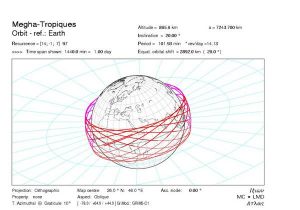The key of this mission is the repetitivity of the measurement in the Tropics. One has to combine the choice of the inclination of the orbit, the scanning capability of the instruments and the height of the orbit. The limitation of the swath is determined mainly by the microwave imager, which has a conical swath. Simulations have shown that it was possible to obtain a repetitivity of more than 3.5 visibilities per day of each point of the zone situated between 22°S and 22°N for an orbit inclination of 20° at 866-km height. The repetitivity reaches more than 5 per day around 13°N and 13°S.
Find here a compilation of figures regarding the orbitography of MT

Figure 1 : Megha-tropiques orbit for a 1-day period.
Megha-Tropiques (MT) is a LEO satellite, with circular orbit, with the following characteristics:
- Semi-major axis a = 7243.679 km
- Altitude h = 866 km
- Recurrent cycle: 7 days
- 97 revolutions in the cycle (6.87 d)
- Grid interval: 3.711° or 413 km
- The precession cycle is short : 51 days
The originality of the MT orbit is its inclination of 20 degrees. Other particular point, resulting of the 20-degree inclination : for the latitudes between 10° and 25° (North and South), the temporal sampling is represented:
- by a « pack » of overpasses
- followed by a « lack » (without overpass)
For more information on the MT orbit, please find the Megha-Tropiques Technical Memorandum n°1 on this web site.
Scanning ground track for ScaRaB instrument during one day: Across track swath
Scanning ground track for MADRAS instrument during one day: Conical swath
Ground track with LMT (notation of the Local Solar Mean Time)
For a given area, the overpass of MT is done at variable local time: all times of the day are possible and a given local time occurs every 51 days. In some conditions, as those shown here in the video, the northern hemisphere is seen in daylight by MT and the southern hemisphere on night-time. This situation occurs when the local time of the ascending node is at 6 am. It will be the same every 51 days. But, in a half-cycle (26 days), the situation will be conversely: the north hemisphere on night-time and the southern oi daylight. Between those two extreme cases, all intermediate situations are possible.